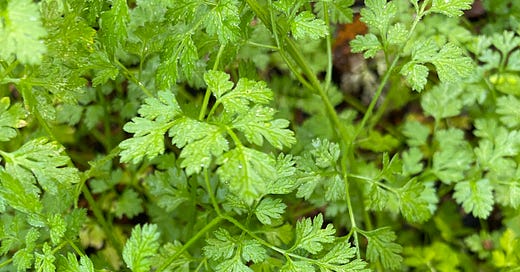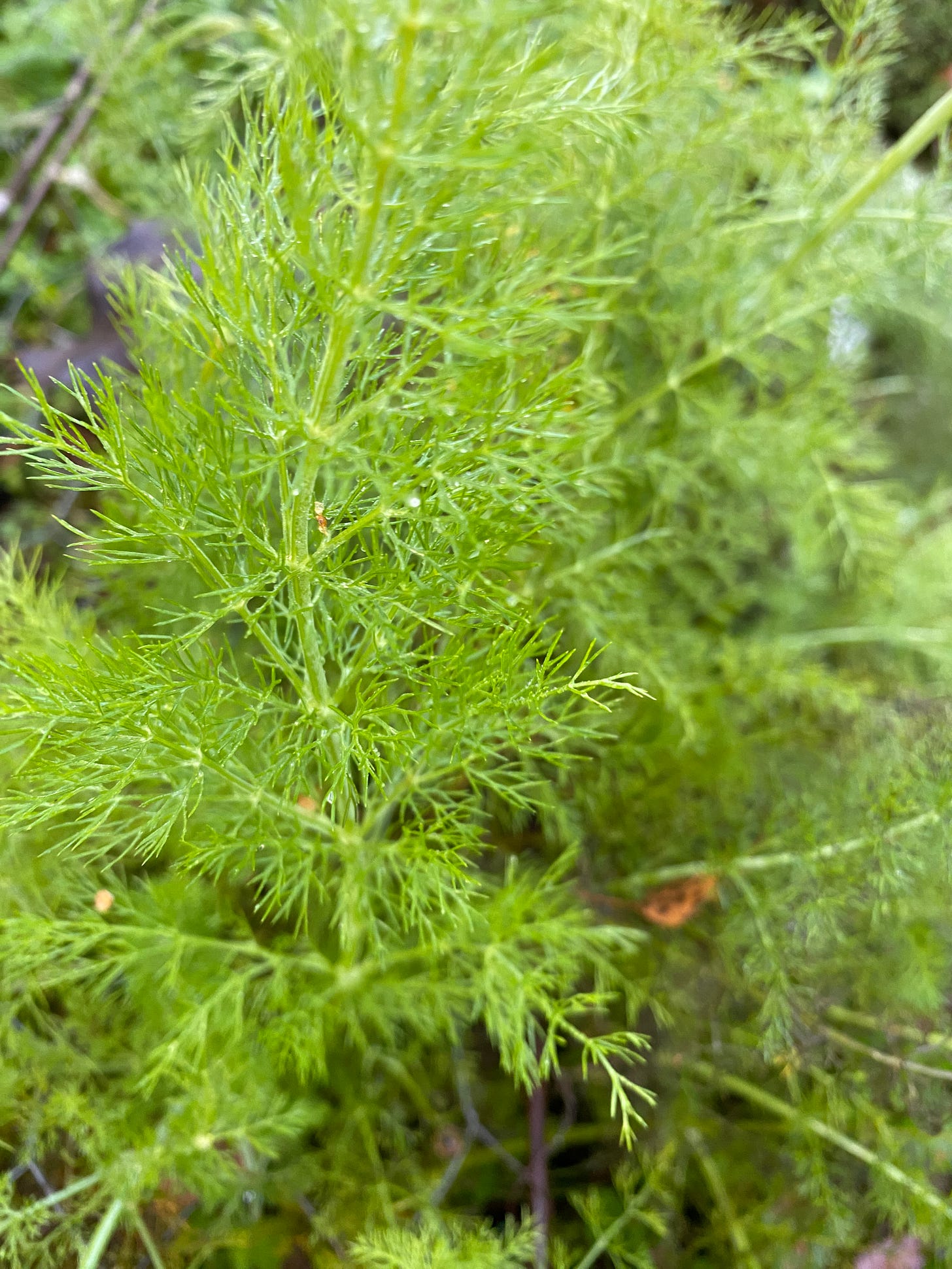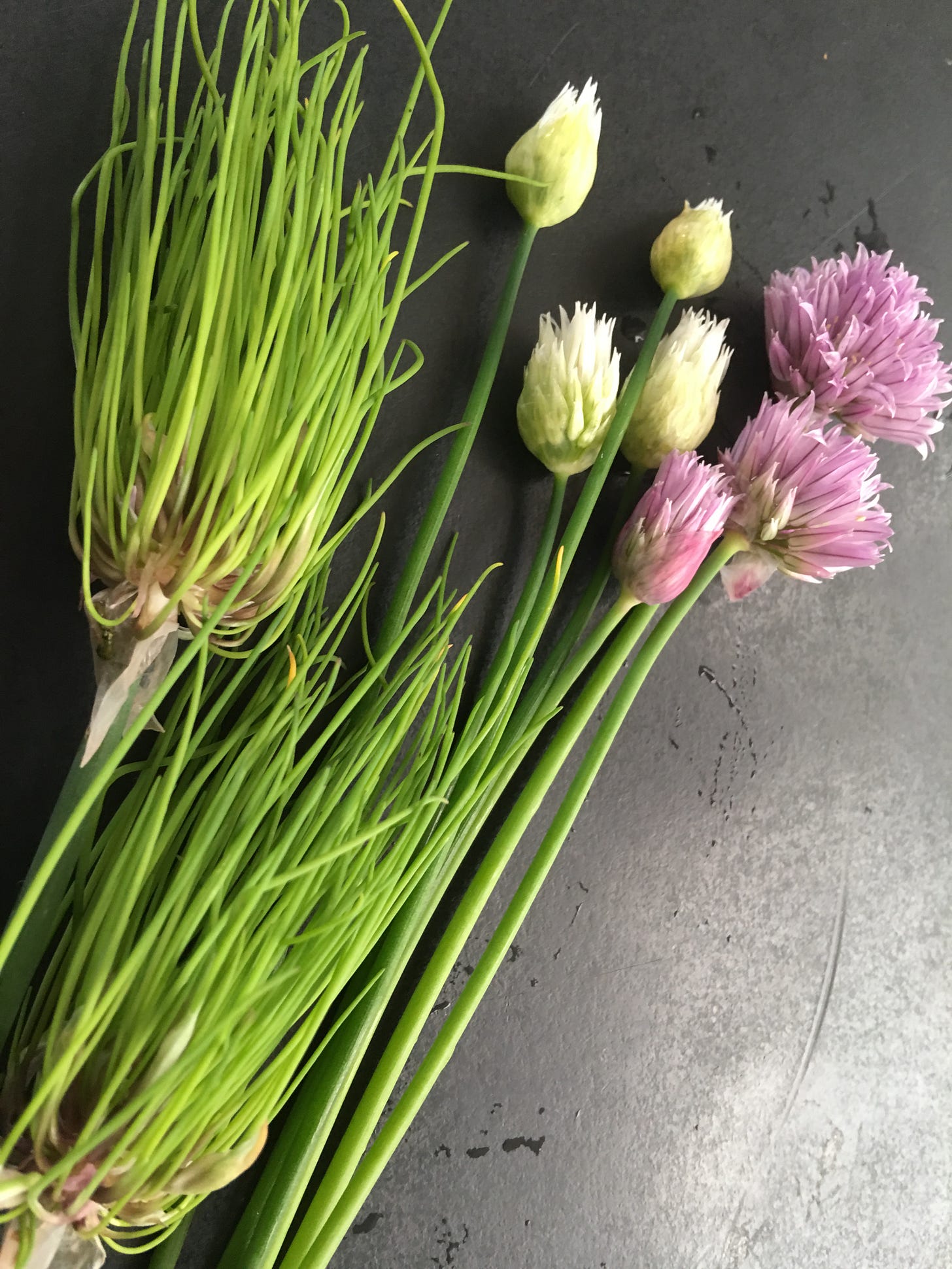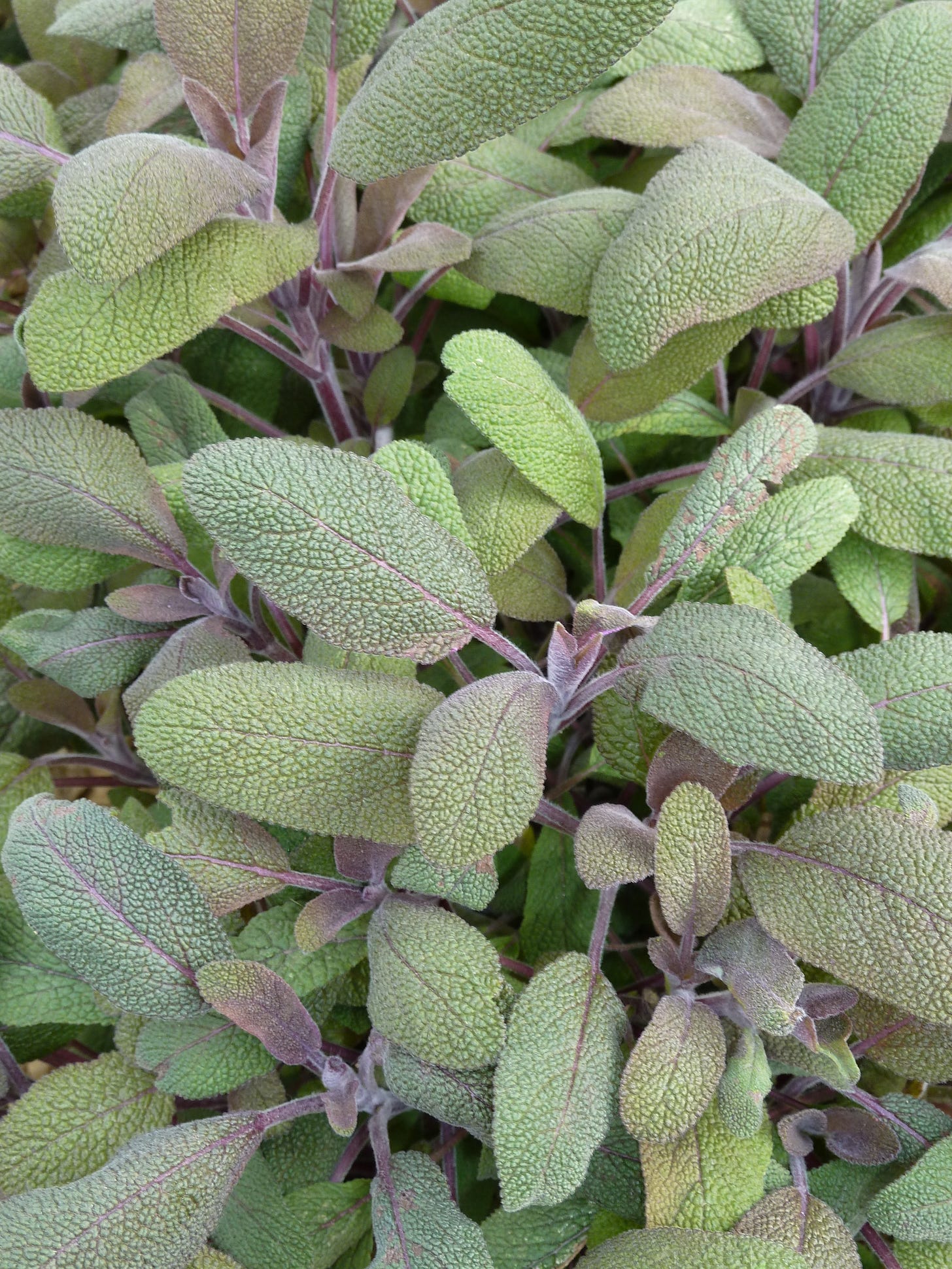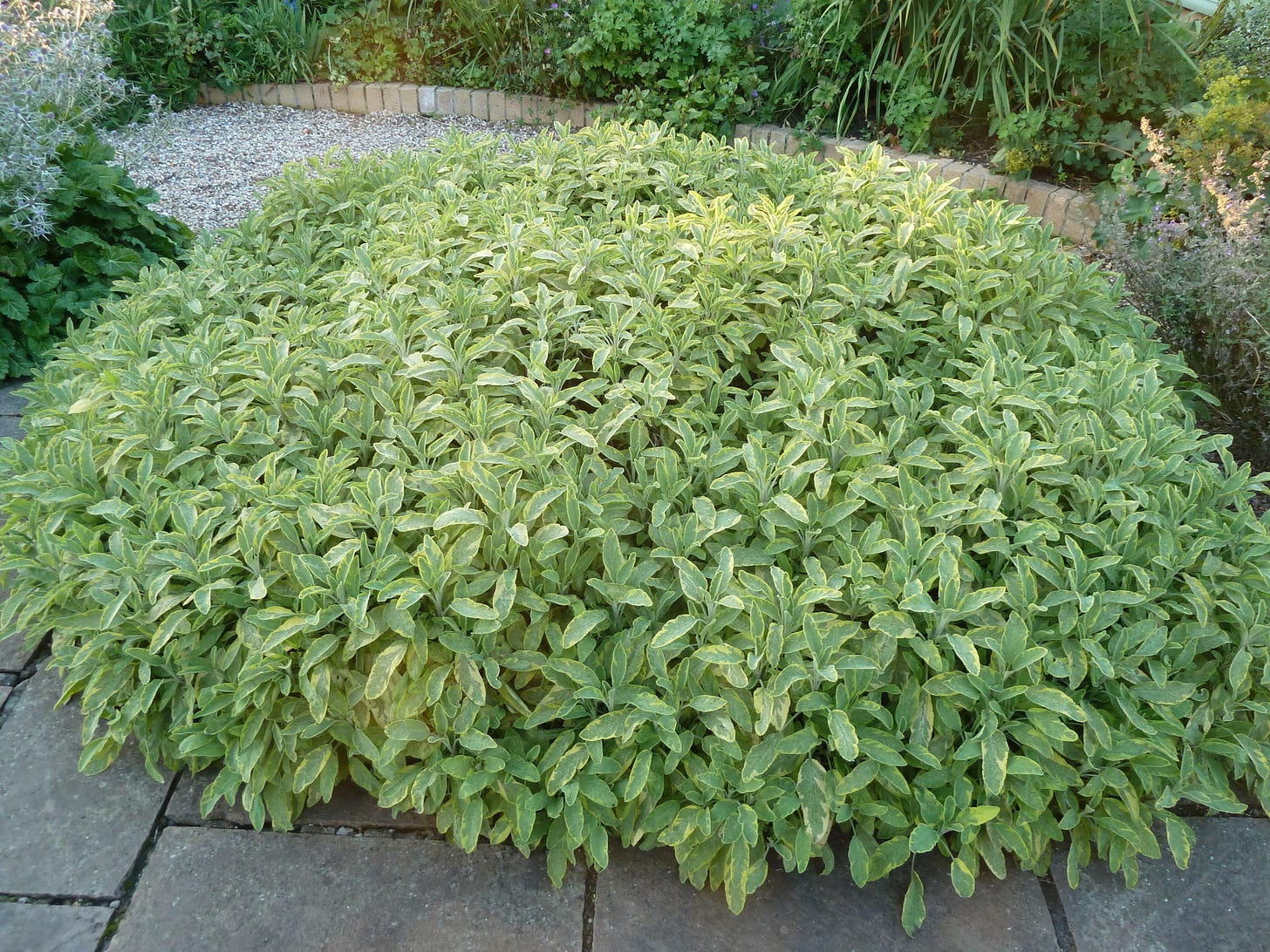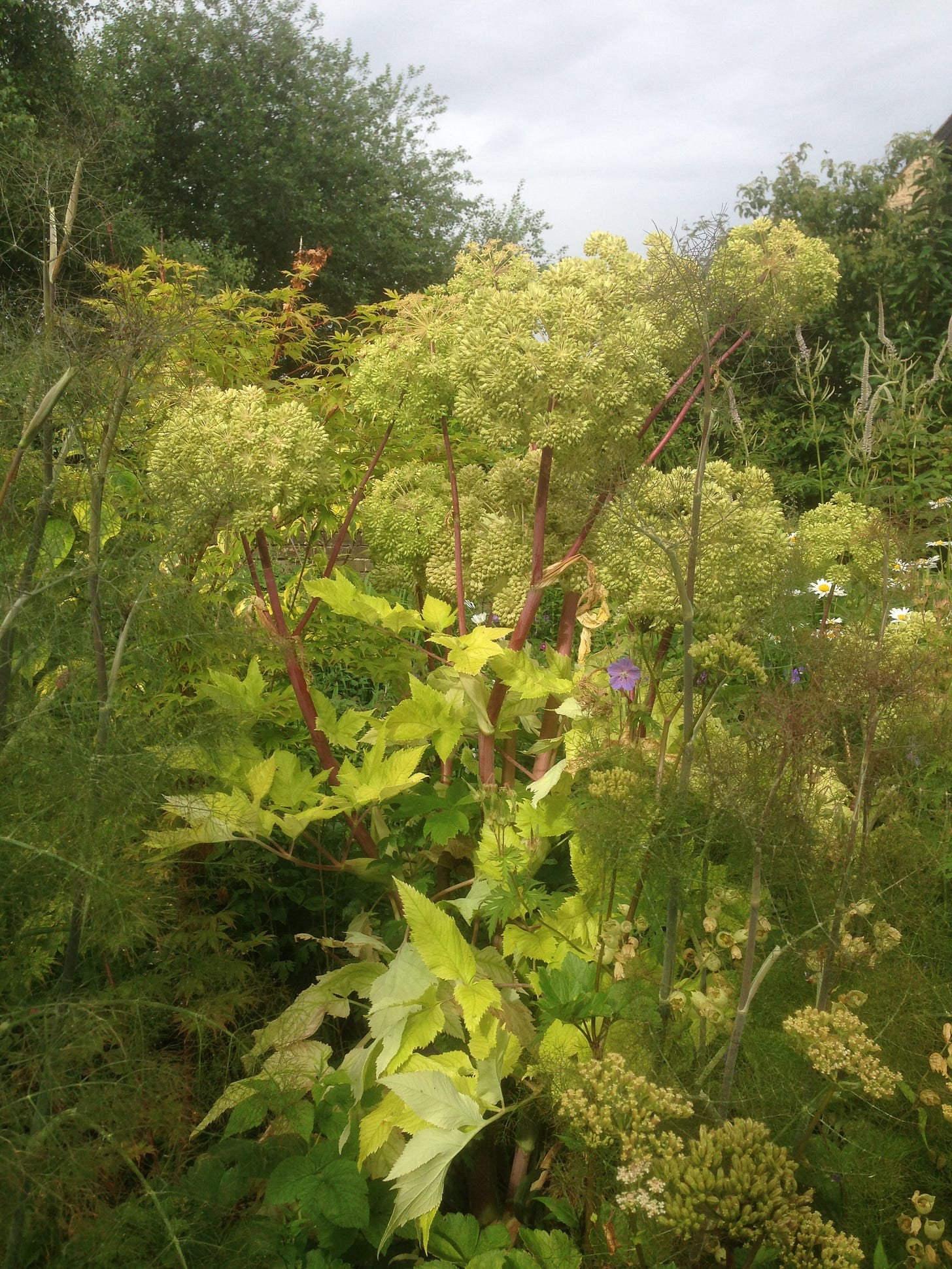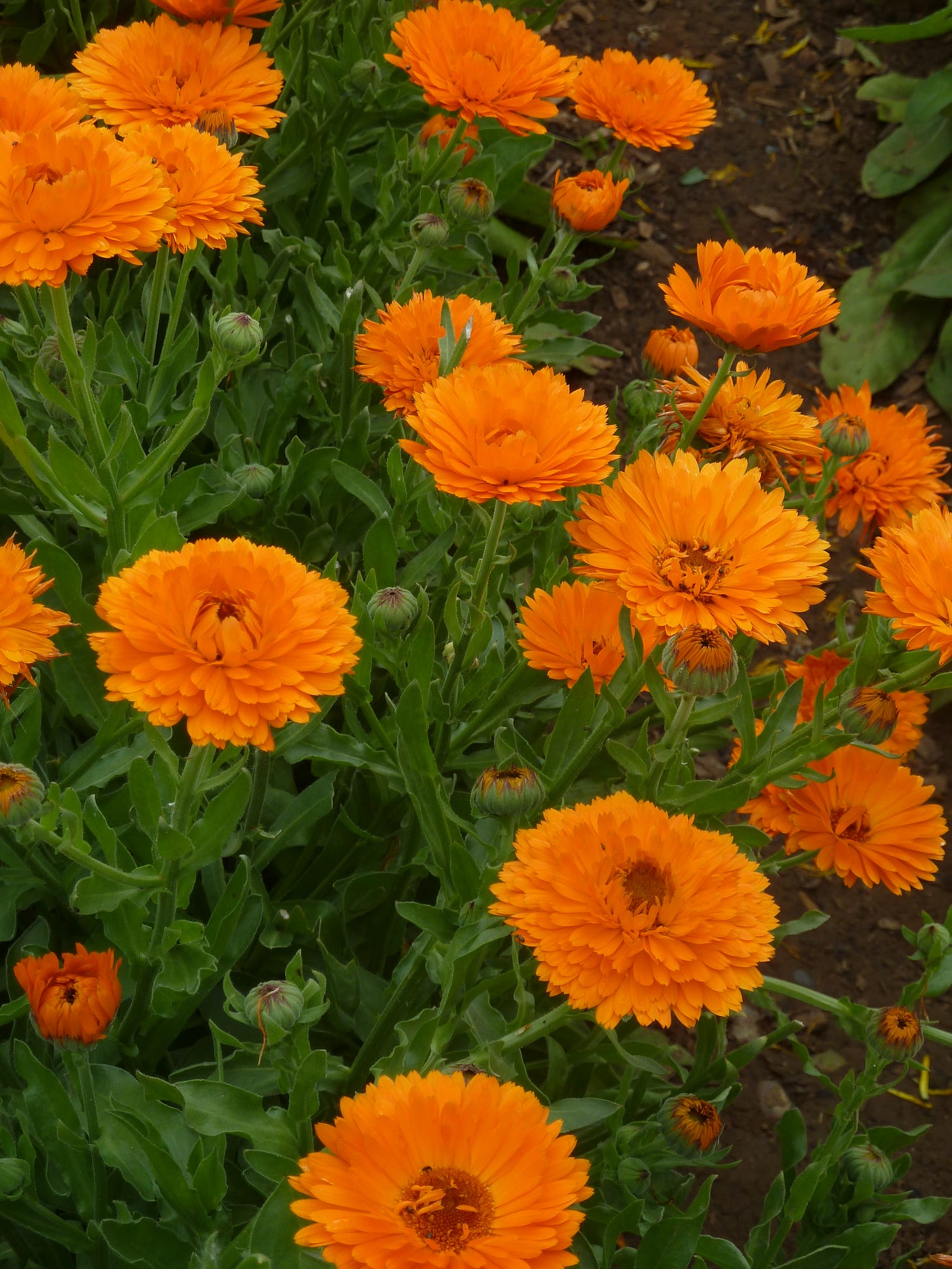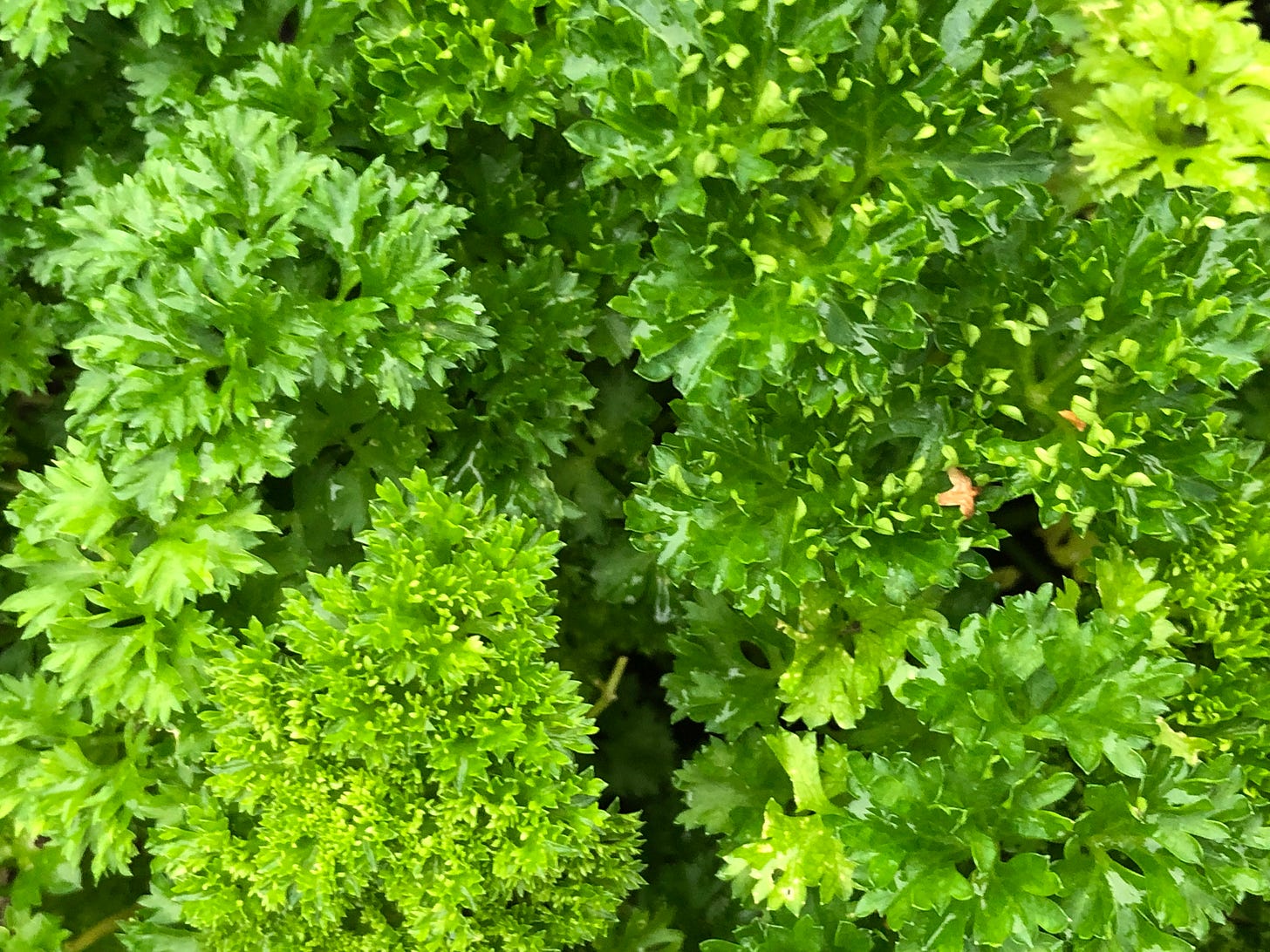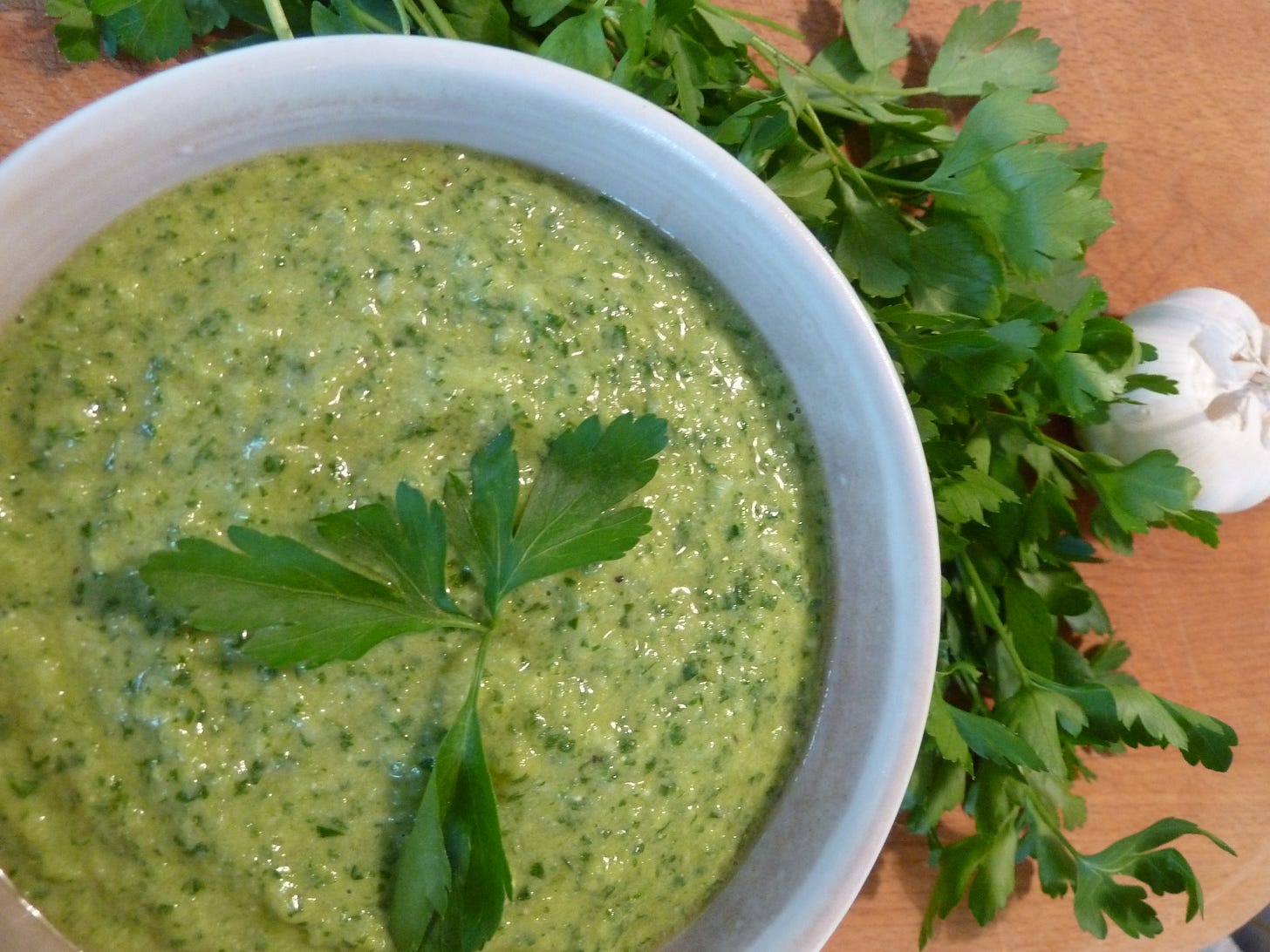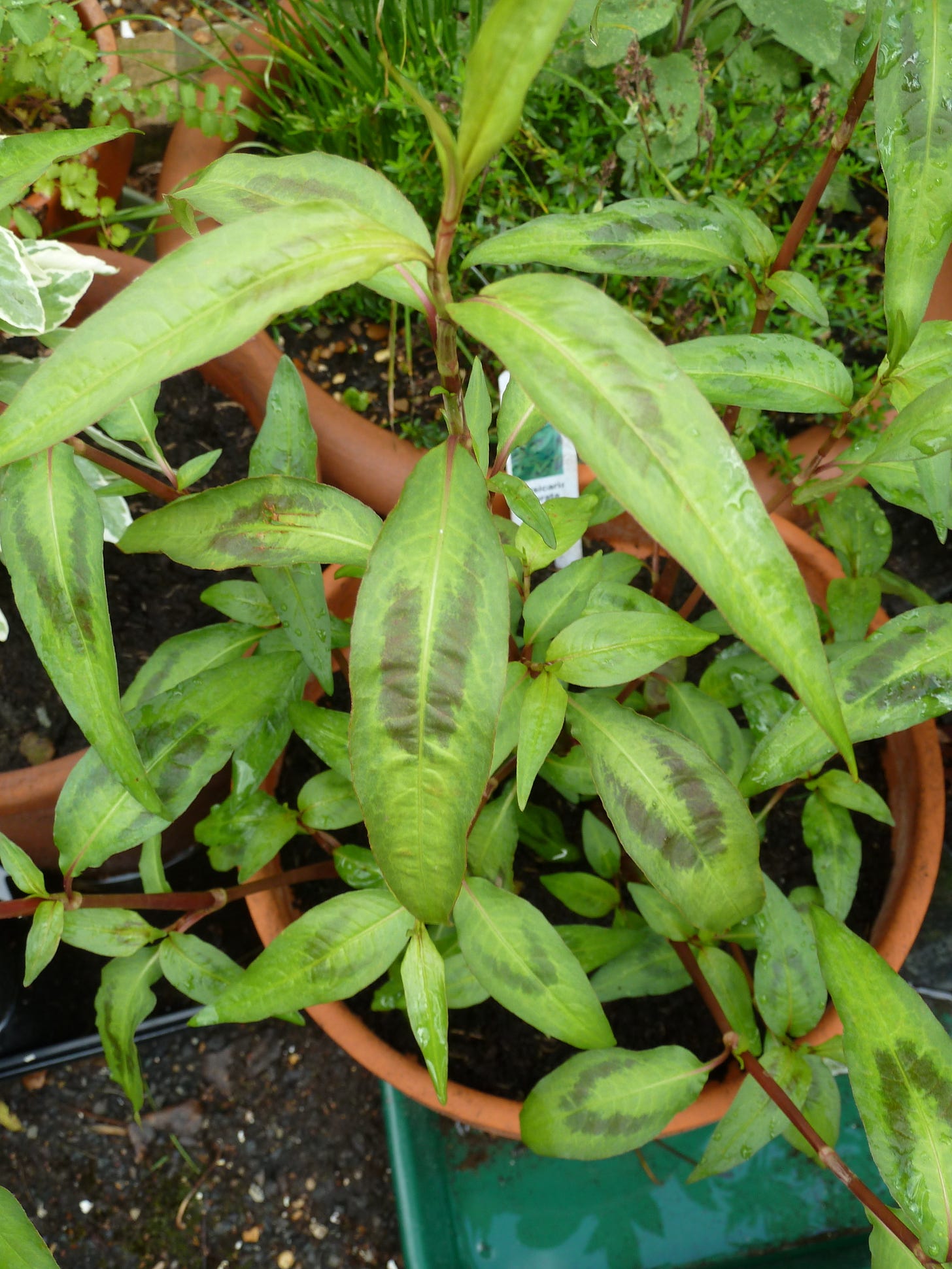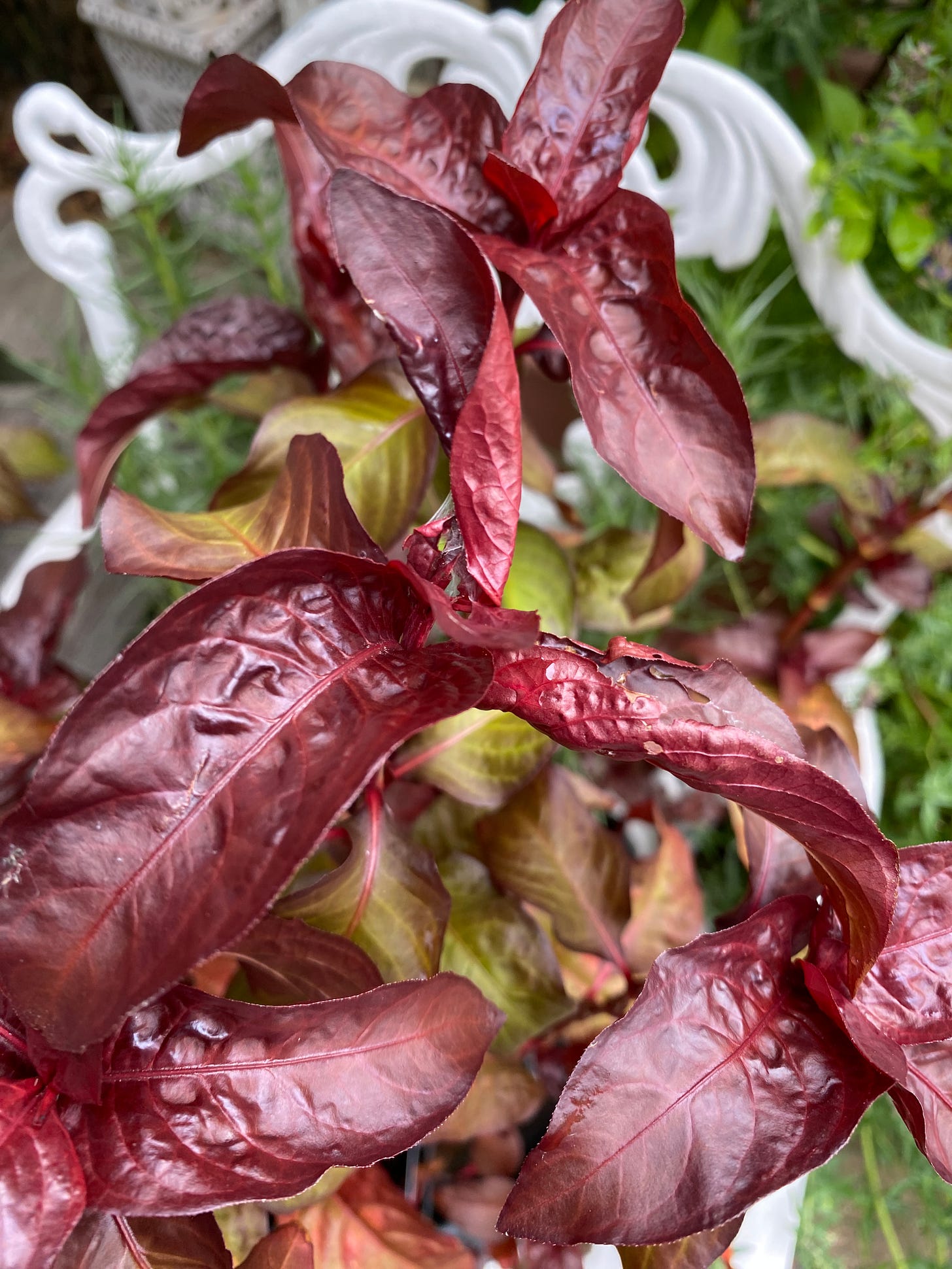And here is Part 2 of December in my herb garden...
Day 8
Chervil (Anthriscus cerefolium). If I am really put on the spot and asked what is my favourite herb… then this one… chervil … would have to feature. I love its aniseed flavour and soft feathery foliage. It has white umbelliferous flowers in summer followed by a mass of seeds… and that is why I have a chervil forest scene going on in my herb garden. I am not complaining! It is one of the traditional herbs in fines herbes bundles in French cuisine. It does best in part shade where it will produce abundant foliage. If it is in full sun it will go to seed prematurely. I let the self-sowers go where they will but I also sow it on a regular basis so that I have chervil foliage in quantity throughout the growing season.
It is a hardy annual. For me it is the perfect herb for a plain herb omelette and I also mix it in with other herbs such as parsley and chives.
Day 9
Fennel (Foeniculum vulgare) is a herb I enjoy so much in the kitchen and in the herb garden I love seeing the little yellow umbelliferous flower heads dance with insects in summer. It grows to a height up to 2.1 m (7 ft) 45 cm (18 in) spread so is best sown straight into a permanent site. Its statuesque height makes it one of the best herbs for a focal point in the herb garden.
There are two forms, bronze and green, they have same flavour but offer different looks in salads and in the garden. Fennel pollen is a much sought-after ingredient and expensive to buy. I make successional sowings every few weeks in spring to keep the leaves cropping going over the summer.
The feathery foliage is attractive on the plant as well as in salads and in cooked dishes. I always use it with baked fish, and in egg dishes, including egg mayonnaise.
I cut the tall stems back in autumn once I have harvested the seed and soon the fennel plants shoot back, offering fresh green and bronze stems packed with flavour.
In early December 2023 the frost looked like it had done for my fennel but it has bounced back.
Day 10
Chives (Allium schoenoprasum). This hardy perennial with fine green foliage and mauve or white pom-pom flowers is one of the delights of the summer herb garden. You can pot it up and grow it over winter… but with all the supermarkets offering packs of fresh chives, this might be overkill. I grow them in sun and shade and would love to have the space to plant them along a bed edge or a path. I always cut them back after flowering to have a second flush of foliage shooting up for another round of tasty uses.
Chives offer onion flavour without the tears and the flowers look so pretty in salads. My top uses are for salads, egg dishes and soups. Chives is one of the traditional herbs of a fines herbes bundle. If you are using it in hot dishes, add it at the last moment of cooking as its flavour is quickly lost when cooked for a long time. I grow the purple-mauve flowered form and struggle with the wonderful white-flowered form. They never seem to survive from year to year as the purple form does. My favourite though is ‘Cha Cha Chives’ which instead of a coloured flower produces a head of thin chive seedlings. I always pot up a few and soon have several pots of them on the go. The little seedling/shoots are also useful and attractive in salads, with cheese and in sandwiches.
Day 11
Sage (Salvia officinalis) has a powerful, almost camphor-like aroma so needs to be used sparingly. I use it with meat such as pork for a stuffing with prunes or onions, or with apples to make a sauce. I also use it with pumpkin in a soup or squash in roasted dishes. But best of all I like dipping leaves in a light tempura batter.
In the garden if left to go to flower in summer it is a bee-magnet. There are several different leaf colour ways so it is also a versatile garden plant.
Purple, golden and tricoloured sages make great ornament plants and they do as well in the ground as in containers. Not all sages are hardy. S. elegans (pineapple scented leaves) need to be over-wintered in frost-free conditions. It is a hardy perennial, although in a frost it may look a little overwhelmed, but not for long.
Day 12
With common names including Mexican mint, Spanish thyme or Jamaican broad-leaf thyme, Cuban oregano (Plectranthus amboinicus) offers a range of flavours in its soft hairy foliage. Its powerful punch tunes up casseroles and soups, especially in winter cooking. Its lovely leaves are scalloped or toothed at the margins and hair on both surfaces. It offers a strong meaty aroma to casseroles and soups, similar to thyme and marjoram.
It is a tender perennial so I overwinter it in my greenhouse. In South Africa where I first grew it and used it, it is commonly known as the ‘Vicks’ plant because of the camphor and method aromas in the leaves.
I bring it out of the greenhouse in summer and it often flowers with a tall spike of white flowers. I usually nip the flowers out to keep the foliage coming.
I have always used it cut or snipped into food that needs long cooking, such as casseroles and because it is so hairy I wouldn’t eat it raw.
Day 13
Angelica (Angelica archangelica). Huge leaves, tall stems, big umbels of flowers and so many seeds… would sum up this amazingly statuesque herb. The leaves can be chopped into green herb mixes or used to make a fresh and flavoursome bouillon for fish or shellfish. It is a biennial, making leaves in its first year and producing huge fists of flowers followed by masses of seeds. It can grow to a height of 3-5ft. The young stems are often candied to make green decorations for cakes and desserts. It is also useful to cook stems with rhubarb to reduce acidity.
Day 14
Calendula or pot marigold (Calendula officinalis) is still giving me a little zingy colour in the raised beds in the herb garden, despite it being mid-December. And I do need this little bright burst of colour at the moment. It is a simple hardy annual, although sometimes self-sown seedlings do overwinter. It has a long history of use in so many different cuisines. Since I have failed to produce sufficient (should really say any) stamen strands of saffron from the bulbs I once planted, I use calendula petals to colour and flavour rice. I also use it to flavour and brighten the look of salads: who could fail to have their culinary spirits lifted by this colander of colour from a summer harvest? It has daisy-like flowers, single or double, that vary in colour from pale cream, yellow to deep orange. The whole plant is aromatic. Marigolds can be grown in most soils in full sun.
And they self-seed prolifically... but I also help, since I snip off the spent flowerheads and ripening seedheads, often splitting them up in my hand and dropping the seeds there, here and everywhere in the garden. I do deadhead spent flowers regularly to keep flowering going, but eventually I let them go to seed.
Nothing nicer than a burst of orange at any time of year. Calendula is known for its soothing antiseptic qualities and there are many proprietary hand creams that you can buy, as well as make yourself
My original plants came from Kim Hurst’s Worcestershire nursery, The Cottage Herbery (@thecottageherbery). But sad to say The Cottage Herbery is retired and I have these self-sowers to remind me of Kim and Rob and their wonderful nursery. Kim has written two books packed with facts and tips about the histories and uses of herbs, Hidden Histories of Herbs and A Taste of Herbs. I enjoy dipping into both books to re-read the backstories of the herbs I love to grow.
Day 15
Parsley (Petroselinum crispum) is one of those herbs that is always there and you can easily forget just how useful it is in cooking and how easy it is to grow. There is a lot of folklore about how it only grows well for the woman of the house. It does take a while to germinate but once it does there is no stopping it.
I find it annoying that such a versatile herb is often used as a ‘throw away’ as the plant of choice for a mere garnish… just decorating the plate and the dish! It deserves its place in our kitchens as well as herb gardens.
Parsley is one of the basic herbs for culinary use, being another of the herbs known as fines herbes. In the kitchen I love using it chopped fresh into omelettes or into a tabbouleh, where it is combined with chopped tomato. I use flat leaf and curly parsley to make a green sauce or salsa verde.
Parsley is a hardy biennial growing to a height of 12 - 24in when in flower. It produces greenish white flowers in the second year. I let plants go to seed and always find fresh seedlings appearing. I also sow it several times so there is usually a fresh plant or two on the go! There are various forms with heavily curled, almost mossy foliage, as well as the flat-leaf form. All are good for salads and flavouring.
I grew Hamburg parsley last year for its roots. Its leaves look like flat leaf parsley but it was the roots that I was after. It is sold in many European markets as a root vegetable. The roots were smaller than parsnips and in my opinion had much more flavour!
In the herb garden I have grown it as a short-lived edging plant. As it is a biennial, producing leaves in its first year and sending up flower stems and setting seed in it second year, it will only have a neat shape in that first year.
Day 16
Most years I grow Vietnamese coriander (Persicaria odorata) for its pungent spicy leaves that flavour soups, stews and can be used fresh in salads. It has many common names including Vietnamese coriander, hot mint and laksa leaf. In our mild temperate climate it is not hardy though I have managed to keep it in mild winters outdoors. Usually, I take cuttings and root them in water, then plant them up into individual pots and keep them in a heated greenhouse over winter. The tender young leaves have the best flavour. Outdoors it thrives in a sunny site in containers or in the ground but does need winter protection in most areas.
New to me this year was red water pepper (Persicaria hydropiper rubra) which I bought on my last visit to the The Cottage Herbery. It has vibrant ruddy foliage and stems, and curved pink flower spikes in late summer. I grew it in containers where it was admired as much for its ornament as for the heat and tangy spiciness of its leaves. Kim Hurst who sold it to me said it was much used in coconut milk-based curries, in salads, stir fries with fish or poultry. It needs a moisture-retentive soil and like P.odorata needs frost protection. I took cuttings at the end of summer and they and one or two plants are sheltering in the greenhouse overwinter.
Day 17
Garlic chives (Allium tuberosum) have distinctly garlic-flavoured strappy leaves and white flowers arranged in a typical umbellifer-shape. It self-seeds generously I am pleased to say! I usually have a little forest of self-seeders on the go. I have also grown it in containers, I use it in salads and omelettes, with leaves snipped into smaller pieces. The flowers, when just opened, are decorative and flavoursome too. The buds like those of chives are good in salads.

